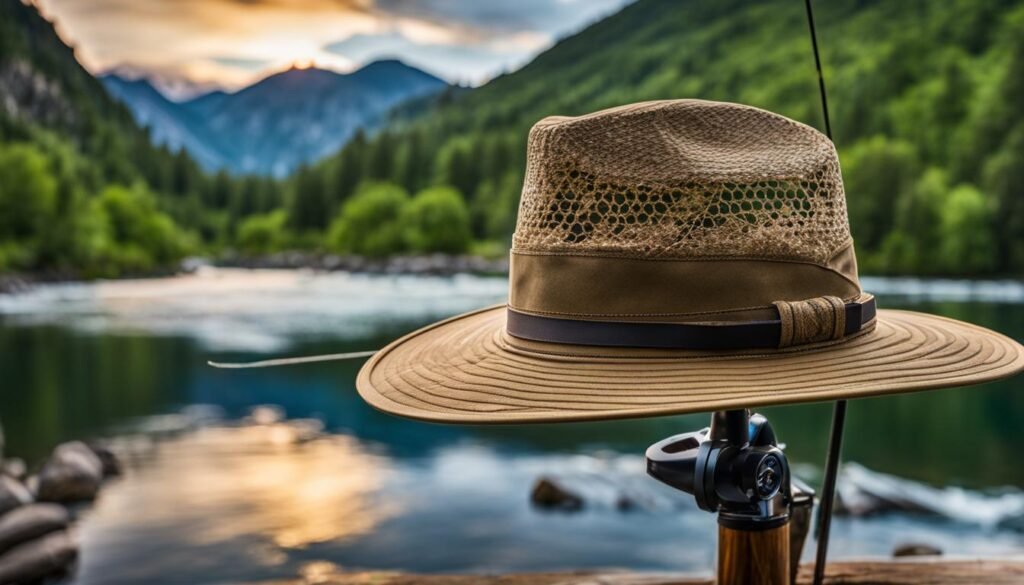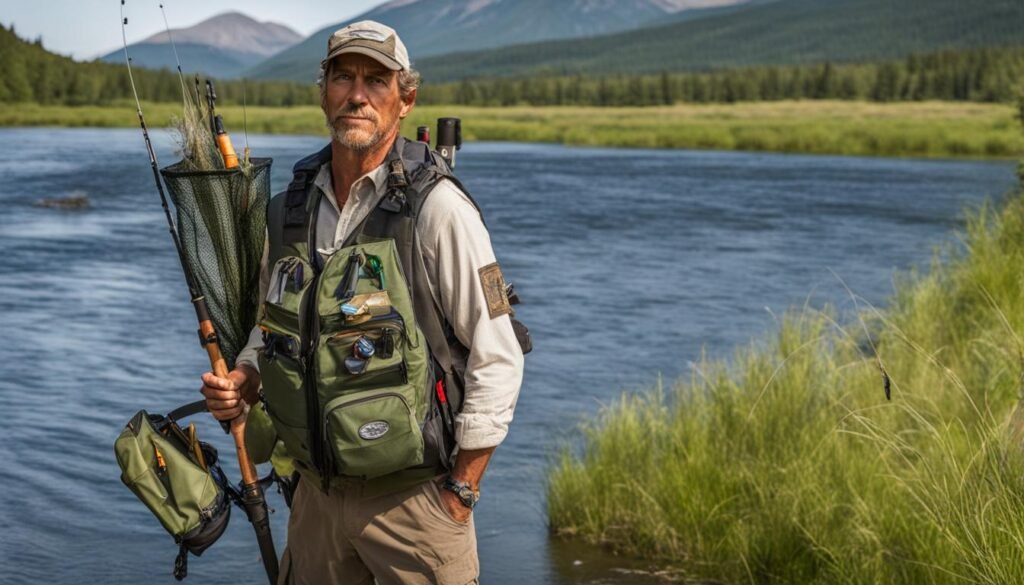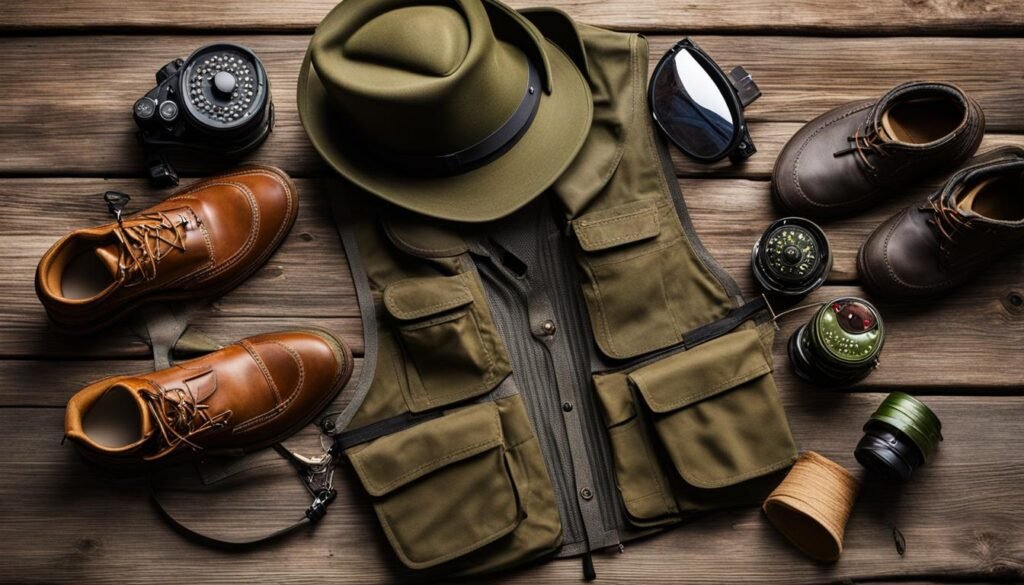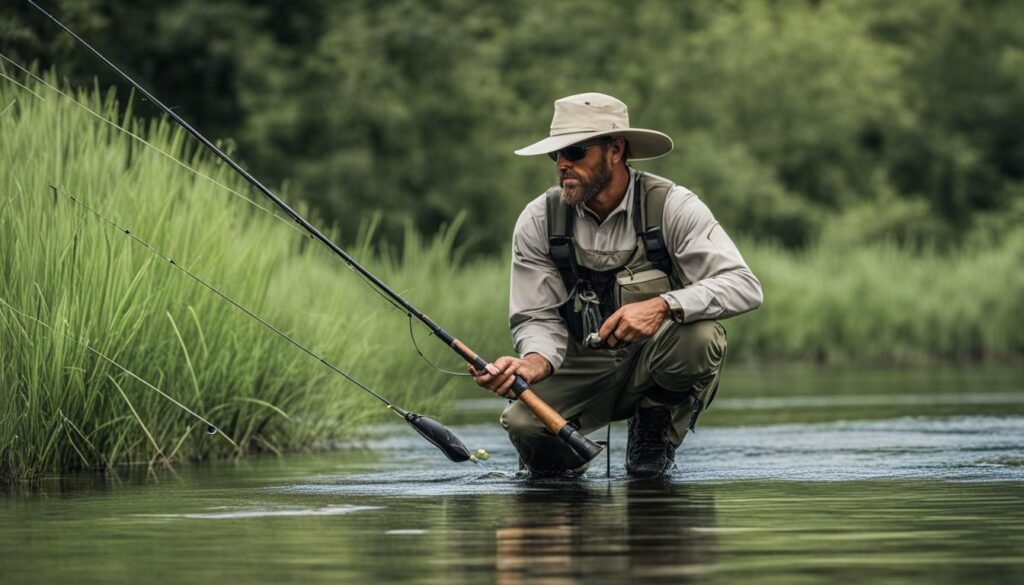Fly fishing requires the right apparel to ensure comfort, protection, and functionality on the water. From waders to boots, sunglasses to vests, and everything in between, selecting the right fly fishing gear is essential for a successful day on the water. In this guide, we will explore the different types of fly fishing apparel available and how to choose the right gear based on your specific needs and fishing conditions.
Essential Fly Fishing Clothing
Fly fishing apparel includes clothing items specifically designed for anglers. These garments offer protection from the elements, comfort for long hours on the water, and functionality for casting and reeling in fish. Essential fly fishing clothing items include fishing shirts, pants or shorts, hats or caps, and gloves. High-quality, lightweight, and moisture-wicking fabrics are recommended for fly fishing apparel to provide comfort and protection from the sun, wind, and water.
When selecting fishing shirts for fly fishing, look for long-sleeved options with UPF (ultraviolet protection factor) ratings to shield your skin from harmful UV rays. Breathable and quick-drying materials like nylon or polyester are ideal for staying comfortable and dry throughout your fishing trips. Additional features to consider include vented panels for airflow, roll-up sleeves for versatility, and buttoned or zippered pockets for convenient storage of small items like flies or tippet.
For pants or shorts, choose lightweight and durable options that allow ease of movement. Look for water-resistant or quick-drying fabrics that can withstand splashes or sudden rain showers. Some fishing pants also feature zip-off legs, offering the flexibility to switch between pants and shorts as weather conditions change. Consider pants or shorts with multiple pockets for storing essential fishing accessories, such as forceps or extra fly boxes.
| Fishing Shirt Features | Pants/Shorts Features |
|---|---|
| UPF rating for sun protection | Lightweight and durable |
| Breathable and quick-drying | Water-resistant or quick-drying fabric |
| Vented panels for airflow | Zip-off legs for versatility |
| Buttoned or zippered pockets for storage | Multiple pockets for essential accessories |
When it comes to headwear, hats or caps are essential for sun protection and improving visibility on the water. Look for wide-brimmed hats with UPF ratings to shield your face, neck, and ears from the sun. Hats with dark-colored underside brims can reduce glare, allowing you to see more clearly. Caps with built-in sweatbands are helpful for keeping perspiration at bay during hot summer days. Consider choosing hats or caps with adjustable straps or closures for a secure and comfortable fit.
Gloves are another important piece of fly fishing clothing, especially for colder climates or when handling fish with teeth or spines. Neoprene gloves provide insulation and are ideal for keeping hands warm in chilly waters. Look for gloves with reinforced palms for added durability and grip, allowing you to handle your fishing rod and reel with ease. Consider gloves with finger slits or fold-back fingertips for improved dexterity when tying knots or manipulating small fishing gear.
Fly Fishing Waders and Wader Boots
Fly fishing waders and wader boots are essential for anglers who want to venture into the water and reach areas that cannot be accessed from the shore. These specialized pieces of fly fishing gear provide protection, comfort, and functionality, allowing you to stay dry and maneuver easily while casting and reeling in fish.
Types of Fly Fishing Waders
There are two main types of fly fishing waders: chest waders and hip waders. Chest waders provide full-body coverage, extending from the feet to the chest, and are ideal for fishing in deep waters such as rivers and lakes. These waders allow anglers to wade into the water without worrying about getting wet. On the other hand, hip waders cover the lower body, reaching up to the waist or hips, and are suitable for shallower streams or rivers where the water level is not too high.
Choosing the Right Size and Fit
When selecting fly fishing waders, it is important to choose the right size and fit for maximum comfort and mobility. Ill-fitting waders can restrict movement and cause discomfort during long hours on the water. Consider factors such as your height, weight, and body shape when determining the size. It is recommended to try on the waders before purchasing them to ensure a proper fit. Additionally, look for adjustable features such as straps and suspenders to customize the fit according to your body shape.
Wader Boots for Traction and Stability
Wader boots are an essential companion to fly fishing waders, providing traction and stability on slippery rocks and preventing the waders from filling with water. These boots are designed with specialized soles that offer excellent grip on various surfaces, including mossy rocks and muddy riverbanks. When choosing wader boots, look for durable materials, such as rubber or felt, that can withstand the demands of fly fishing in different environments. It is also important to ensure that the boots provide a comfortable fit and proper ankle support to prevent injuries and increase stability while wading.
Fly Fishing Sunglasses
Fly fishing sunglasses are a crucial accessory for any angler, providing protection and enhancing visibility on the water. With the sun’s harmful UV rays and the glare from the water’s surface, it’s essential to invest in a pair of high-quality sunglasses that are specifically designed for fly fishing.
When choosing fly fishing sunglasses, there are a few key factors to consider. First and foremost, look for sunglasses with polarized lenses. These lenses help to reduce glare, allowing you to see beneath the water’s surface and spot fish more easily. Polarized lenses also provide better clarity and contrast, enhancing your overall fishing experience.
Additionally, it’s important to select sunglasses with frames that fit comfortably on your face. Look for lightweight frames that won’t cause discomfort during long days on the water. It’s also recommended to choose sunglasses with scratch-resistant lenses and maximum UV protection to ensure long-lasting durability and eye safety.
Lastly, consider the lens color that best suits your fishing conditions. Amber lenses are ideal for low-light conditions, while gray lenses are suitable for bright sunlight. Green lenses offer excellent contrast and are a versatile choice for various lighting conditions. Take into account the specific fishing conditions you’ll be facing and choose a lens color that will optimize your visibility on the water.
| Lens Color | Fishing Conditions |
|---|---|
| Amber | Low-light conditions |
| Gray | Bright sunlight |
| Green | Versatile for various lighting conditions |
Fly Fishing Hats and Caps

Fly fishing hats and caps serve a dual purpose of providing shade and protection from the sun while also adding style to your fly fishing outfit. When selecting a hat or cap for your fly fishing adventures, consider the following:
Style and Design
Choose a hat or cap that suits your personal style and preferences. There are various designs available, including wide-brimmed hats, trucker caps, and bucket hats. Additionally, consider the color and pattern that align with your taste.
Sun Protection
Opt for hats and caps that offer UPF (ultraviolet protection factor) rating to shield your face and neck from harmful sun rays. Wide-brimmed hats with a UPF rating are particularly effective in providing maximum sun protection.
Breathability and Comfort
Look for hats and caps that are lightweight and feature mesh crowns or ventilated panels. These design elements allow for better airflow and breathability, keeping you cool and comfortable during long days on the water.
Adjustability
Ensure that the hat or cap you choose has adjustable features, such as a strap or drawstring, to customize the fit according to your head size. This will help keep the hat securely in place, even in windy conditions.
Fly Fishing Vests and Packs

Fly fishing vests and packs are essential for any angler looking to keep their gear organized and easily accessible on the water. These handy accessories provide storage space for all your fishing essentials, allowing you to focus on the thrill of casting and reeling in fish. Whether you prefer a vest or a pack, there are a few key considerations to keep in mind when choosing the right one for your fly fishing adventures.
Features to Consider
When selecting a fly fishing vest or pack, think about the specific features that will enhance your fishing experience. Look for options that offer multiple pockets and compartments, as well as D-ring attachments for securing tools and accessories. Rod holders can be a convenient addition for keeping your rod within easy reach, and waterproof compartments are great for protecting valuables from water damage. Additionally, adjustable straps and a comfortable fit are essential for ensuring that your vest or pack doesn’t restrict your movement or cause discomfort during long days on the water.
Comparing Vests and Packs
Both fly fishing vests and packs have their advantages, so it ultimately comes down to personal preference. Vests are a classic choice and are known for their numerous pockets and storage options. They distribute weight evenly across your shoulders and provide easy access to your gear. Packs, on the other hand, offer greater storage capacity and can be worn like a backpack, which can be more comfortable for long hikes or extended fishing trips. They are also a popular choice for anglers who prefer a minimalist approach or need to carry larger items like lunch or a camera.
| Fly Fishing Vests | Fly Fishing Packs | |
|---|---|---|
| Storage Capacity | Smaller | Larger |
| Pockets and Compartments | Multiple | Varies |
| Weight Distribution | Evenly across shoulders | Across back |
| Accessibility | Easy access to gear | May require removal to access gear |
| Mobility | More freedom of movement | May restrict movement |
Fly Fishing Gloves
Fly fishing gloves are an essential piece of gear that provides protection and functionality while out on the water. Whether you’re handling fish, tying knots, or simply protecting your hands from the elements, a good pair of fly fishing gloves can make all the difference. When choosing fly fishing gloves, consider factors such as material, fit, and durability to ensure maximum comfort and performance.
Materials
Fly fishing gloves are typically made from neoprene or quick-drying materials. Neoprene gloves provide excellent insulation and are ideal for colder fishing conditions, as they retain heat and keep your hands warm. Quick-drying materials, on the other hand, are great for warmer weather as they wick away moisture and keep your hands dry and comfortable. Consider the fishing conditions you’ll be facing and choose gloves accordingly.
Fit
Proper fit is crucial when it comes to fly fishing gloves. You want them to fit snugly without restricting movement or compromising dexterity. Look for gloves that have adjustable straps or closures to ensure a secure fit. Additionally, gloves with reinforced fingertips and palm areas offer added durability and protection, especially when handling sharp hooks or abrasive surfaces.
Functionality
Functionality is key when choosing fly fishing gloves. Look for gloves that provide a good grip, allowing you to maintain control while handling fish or manipulating gear. Gloves with finger mobility are important for maintaining tactile sensitivity and ease of movement. Consider gloves with fold-back fingertips, which allow you to easily use your fingers for tasks that require more precision, such as tying knots.
| Glove Material | Pros | Cons |
|---|---|---|
| Neoprene | Excellent insulation | Less breathable in warm weather |
| Quick-drying | Moisture-wicking, suitable for warm weather | Less insulation in cold weather |
| Hybrid (Neoprene/Quick-drying mix) | Combines insulation and quick-drying properties | May be more expensive |
Fly Fishing Accessories

In addition to the essential fly fishing clothing and gear, there are various accessories that can enhance your angling experience. These accessories are designed to make your fly fishing adventures more enjoyable and successful. Whether you’re organizing your flies, cutting line, or keeping your dry flies afloat, the right accessories can make a big difference on the water.
Here are some popular fly fishing accessories:
- Fly Boxes: These boxes help you organize and store your flies, making it easier to find the right pattern when you need it.
- Nippers and Hemostats: Essential tools for cutting line and removing hooks, ensuring you’re always prepared on the water.
- Zingers: These retractable holders keep your tools securely attached to your vest or pack, preventing them from getting lost in the water.
- Floatants: Keep your dry flies riding high on the water’s surface with these specialized substances that prevent them from sinking.
- Strike Indicators: These small, buoyant devices help you detect subtle strikes from fish, improving your chances of a successful hookset.
- Fly Line Cleaners: Keep your fly line in top shape with cleaners that remove dirt and debris, allowing for smoother and more accurate casts.
- Hook Sharpeners: Ensure your hooks are razor-sharp for optimal hook penetration and fish-holding power.
Choosing Quality Fly Fishing Apparel Brands
When it comes to fly fishing, having the right gear is essential for a successful and enjoyable experience on the water. One important aspect of fly fishing gear is the apparel you choose to wear. From shirts and pants to waders and hats, selecting high-quality fly fishing clothing brands is crucial. Here are some tips to help you choose the best brands for your fly fishing needs.
Reputation and Quality
When selecting fly fishing apparel brands, it’s important to consider their reputation and the quality of their products. Look for brands that have a long history in the industry, as they have likely established themselves as trusted providers of quality gear. Read customer reviews and ratings to get an idea of the brand’s overall reputation and the satisfaction of their customers. Pay attention to the material quality and construction of the apparel, as well as any warranty policies offered by the brand.
Specific Fishing Needs
Consider your specific fishing needs when choosing fly fishing apparel brands. Different brands may specialize in certain types of gear or offer specific features that cater to different fishing conditions. For example, if you frequently fish in cold water, look for brands that offer insulated and waterproof apparel. If you often fish in hot weather, consider brands that prioritize lightweight and breathable materials. Understanding your fishing needs will help you choose brands that offer the most suitable gear for your adventures.
Well-Known Brands
There are several well-known fly fishing apparel brands that consistently produce high-quality gear. Some popular options include Patagonia, Orvis, Simms, Redington, and Fishpond. These brands offer a wide range of clothing options, from shirts and pants to waders and accessories, ensuring that you can find everything you need for your fly fishing adventures. Explore their product offerings, compare prices and features, and choose the brand that best aligns with your preferences and budget.

